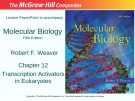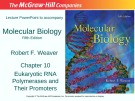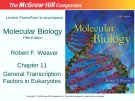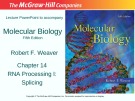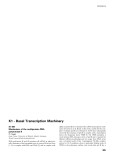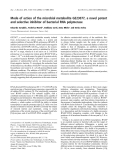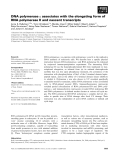
Eukaryotic RNA polymerases
-
The main contents of this chapter include all of the following: Categories of activators, structures of the DNA-Binding motifs of activators, independence of the domains of activators, functions of activators, interaction among activators, regulation of transcription factors.
 53p
53p  tangtuy05
tangtuy05
 30-03-2016
30-03-2016
 63
63
 4
4
 Download
Download
-
In chapter 6 we learned that bacteria have only one RNA polymerase, which makes all three of the familiar RNA types: mRNA, rRNA, and tRNA. In this chapter we will see that three distinct RNA polymerases occur in the nuclei of eukaryotic cells. Each of these is responsible for transcribing a separate set of genes, and each recognizes a different kind of promoter.
 31p
31p  tangtuy05
tangtuy05
 30-03-2016
30-03-2016
 62
62
 3
3
 Download
Download
-
Chapter 11 - general transcription factors in eukaryotes. Eukaryotic RNA polymerases, unlike their bacterial counterparts, are incapable of binding by themselves to their respective promoters. Instead, they rely on proteins called transcription factors to show them the way. Such factors are grouped into two classes: general transcription factors and gene-specifi c transcription factors (activators). In this chapter we will survey the general transcription factors that interact with all three RNA polymerases and their promoters.
 38p
38p  tangtuy05
tangtuy05
 30-03-2016
30-03-2016
 80
80
 3
3
 Download
Download
-
In chapter 14, we will see that most eukaryotic genes, in contrast to typical bacterial genes, are interrupted by noncoding DNA. RNA polymerase cannot distinguish the coding region of the gene from the noncoding regions, so it transcribes everything.
 47p
47p  tangtuy05
tangtuy05
 30-03-2016
30-03-2016
 43
43
 2
2
 Download
Download
-
RNA polymerase II (pol II) produces all mRNA in eukaryotic cells. Structures of the ten-subunit core of yeast pol II in free form [1, 2], in complex with DNA and RNA [3], and in complex with alpha-amanitin [4] have elucidated the mRNA transcription mech-anism [reviewed in 5, 6]. Based on this work, models for the com-plete 12-subunit pol II were obtained [7, 8]. We have subsequently solved the first structure of pol II in complex with a transcription factor, the elongation factor TFIIS [9, 10].
 25p
25p  fptmusic
fptmusic
 11-04-2013
11-04-2013
 33
33
 3
3
 Download
Download
-
GE23077, a novel microbial metabolite recently isolated from Actinomadurasp. culture media, is a potent and selective inhibitor of bacterial RNApolymerase (RNAP). It inhibitsGram-positive (Bacillus subtilis) andGram-negative (Escherichia coli)RNAPs with IC50 values (i.e. the concen-tration at which the enzyme activity is inhibited by 50%) in the 10 )8 Mrange, whereas it is not active onE. coliDNA polymerase or on eukaryotic (wheat germ) RNAP II (IC50 values10 )4 Min both cases).
 0p
0p  awards
awards
 05-04-2013
05-04-2013
 55
55
 2
2
 Download
Download
-
DNA polymeraseeco-operates with polymerasesaanddin the replicative DNA synthesis of eukaryotic cells. We describe here a specific physical interaction between DNA polymerase eand RNA polymerase II, evidenced by reciprocal immunoprecipitation experiments. The interacting RNA polymerase II was the hyperphosphorylated IIO form implicated in tran-
 15p
15p  inspiron33
inspiron33
 23-03-2013
23-03-2013
 43
43
 3
3
 Download
Download
-
TBP (TATA - Binding Protein) là protein liên kết đặc hiệu DNA với đoạn trình tự của hộp TATA. TBP có chức năng biến tính DNA và bẻ cong phân tử DNA một góc 90°. Điều này cần thiết để khởi động cho cơ chế phiên mã. TBP bám vào rãnh nhỏ của phân tử DNA bằng một cấu trúc nếp gấp beta. Vai trò của TBP Trong quá trình phiên mã ở những tế bào eukaryote, TBP là thành phần bắt buộc của nhân tố phiên mã TFIID để khởi động chính xác quá trình này đối với...
 5p
5p  heoxinhkute6
heoxinhkute6
 24-11-2010
24-11-2010
 128
128
 14
14
 Download
Download
-
Bất kỳ gene mã hóa protein nào trong tế bào eukaryote đều bắt đầu phiên mã của nó bằng cách lắp ghép phức hệ tiền khởi động RNA polymerase II (PIC - preinitiation complex ) vào promoter. Các promoter, cùng với enhancer, silencer và insulator tạo thành tổ hợp mã đặc hiệu trong hầu hết các mô hình biểu hiện gene.
 5p
5p  heoxinhkute4
heoxinhkute4
 28-09-2010
28-09-2010
 135
135
 14
14
 Download
Download
CHỦ ĐỀ BẠN MUỐN TÌM








